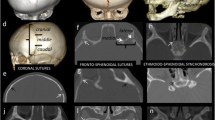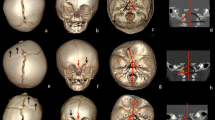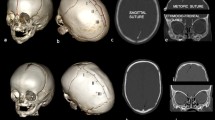Abstract
The aim of this study was to perform a morphometric analysis of the skull base to understand the mechanism of asymmetry between malformational and deformational plagiocephaly. Since 1988, we have carried out 102 CT scans with three-dimensional reconstruction of the endocranial side of the skull base. There were 20 cases of malformational plagiocephaly, consisting of 18 unicoronal synostoses (UCS) and two unilambdoid synostoses (ULS), and 82 cases of plagiocephaly without synostosis, made up of 60 cases of frontal plagiocephaly (FP) and 22 of occipital plagiocephaly (OP). The skull base asymmetry was analyzed in three ways: (1) the hemibases and the cranial fossa angles were compared with each other; (2) the structural asymmetry of the chondrocranium was calculated; and (3) the architectural asymmetry was measured in relation to the medio-labyrinthine plane. The skull base asymmetry of malformational plagiocephaly was located in the anterior and middle cranial fossae for UCS and in the posterior and middle cranial fossae for ULS. The asymmetry was the result of a localized structural anomaly of the chondrocranium. The asymmetry of deformational plagiocephaly corresponded to a distortion in relation to the medio-labyrinthine plane while the chondrocranium remained symmetric. The skull base asymmetry of malformational plagiocephaly is secondary to a localized malformation of the chondrocranium, and that of the deformational plagiocephaly is secondary to an architectural deformation.
Résumé
Le but de cette étude était de réaliser une analyse morphométrique de la base du crâne pour comprendre les mécanismes de l'asymétrie entre les plagiocéphalies malformatives et déformatives. Depuis 1988, 102 reconstructions 3D de la surface endocrânienne de la base et al. âne ont été réalisées. Il s'agissait de 20 plagiocéphalies malformatives, 18 synostoses unicoronales (SUC) et 2 synostoses unilambdoïdes (SUL), et de 82 plagiocéphalies sans synostose, 60 plagiocéphalies frontales (PF) et 22 occipitales (PO). L'asymétrie de la base du crâne était analysée de trois manières: (1) les hémi-bases et les fosses crâniennes étaient comparées les unes aux autres, (2) l'asymétrie structurale du chondrocrâne était calculée, et (3) l'asymétrie architecturale était mesurée par rapport au plan médio-labyrinthique. L'asymétrie de la base du crâne des plagiocéphalies synostotiques était localisée aux fosses crâniennes antérieure et moyenne pour les SUC et aux fosses crâniennes postérieure et moyenne pour les SUL. L'asymétrie était secondaire à une anomalie de structure localisée du chondrocrâne. L'asymétrie des plagiocéphalies sans synostose correspondait à une distorsion autour du plan médio-labyrinthique alors que le chondrocrâne restait symétrique. L'asymétrie de la base du crâne des plagiocéphalies malformatives est secondaire à une malformation localisée du chondrocrâne, et celle des plagiocéphalies déformatives est secondaire à une déformation architecturale.









Similar content being viewed by others
References
Anonymous (1986) Plagiocephaly and torticollis in young infants. Lancet 8510: 789–790
Augier M (1931) Squelette céphalique. In: Nicolas A (ed) Squelette céphalique. Masson, Paris
Berthelsen T (1958) The premature synostosis of the cranial sutures. Acta Ophthalmol Suppl 51: 1-176
Bories J (1996) Le crâne du nouveau-né. Springer, Berlin Heidelberg New York
Bruneteau R, Mulliken J (1992) Frontal plagiocephaly: synostotic, compensational, or deformational. Plast Reconstr Surg 89: 21–31
Burdi A, Kusnetz A, Venes J, Gebarski S (1986) The natural history and pathogenesis of the cranial coronal ring articulations: implications in understanding the pathogenesis of the Crouzon craniostenotic defects. Cleft Palate J 23: 28–39
Clarren S, Smith D, Hanson J (1979) Helmet therapy treatment for plagiocephaly and congenital muscular torticollis. J Pediatr 94: 43–46
Czorny A, Ricbourg B (1997) L'arrière-crâne et ses dysmorphies. Ann Chir Plast Esthét 42: 515–536
Delaire J, Billet J, Ferré J, Faucher O, Julia P (1965) Malformations faciales et asymétrie de la base du crâne(un nouveau syndrome malformatif intéressant l'orthodontiste). Rev Stomatol 66: 379–396
DiRocco C, Velardi F (1988) Nosographic identification and classification of plagiocephaly. Childs Nerv Syst 4: 9–15
Fauré C, Bonamy P, Rambert-Misset C (1967) Les craniosténoses par fusion prématurée unilatérales de la suture coronale. Ann Radiol 10: 31–42
Ferri J, Chevalier C, Robert R, Degrez J, Cloarec AL, Legroux R, Orio E, Barbin J (1989) Reflections on the mechanical structure of the base of the skull and on the face. 1. Classical theories, observed structures. Surg Anat Radiol 11: 41–48
Ferri J, Chevalier C, Robert R, Cloarec AL, Barbin J (1989) Reflections on the mechanical structure of the base of the skull and on the face. 2. Discussion, current concepts and theories. Surg Radiol Anat 11: 135–140
Friede H (1981) Normal development and growth of the human neurocranium and cranial base. Scand J Plast Reconstr Surg 15: 163–169
Genitori L, Zanon N, Denis D, Erdincler P, Achouri M, Lena G, Choux M (1994) The skull base in plagiocephaly. Childs Nerv Syst 10: 217–223
Greene D (1931) Asymmetry of the head and face in infants and in children. Am J Dis Child 41: 1317–1326
Kane A, Lo L, Vannier M, Marsh J (1996) Mandibular dysmorphology in unicoronal synostosis and plagiocephaly without synostosis. Cleft Palate Craniofac J 33: 418–423
Kane A, Mitchell L, Craven K, Marsh J (1996) Observations on a recent increase in plagiocephaly without synostosis. Pediatrics 97: 877–885
Kreiborg S, Bjork A (1981) Craniofacial asymmetry of a dry skull with plagiocephaly. Eur J Orthod 3: 195–203
Leboucq N, Montoya-y-Martinez P, Castan P (1992) Imagerie et pathologie de la base du crâne chez l'enfant. Ann Radiol 35: 424–429
Lo L, Marsh J, Pilgram T, Vannier M (1996) Plagiocephaly: differential diagnosis based on endocranial morphology. Plast Reconstr Surg 97: 282–291
Loomis M, Radkowski M, Pensler J (1990) Maxillary deformation in unilateral coronal synostosis. J Craniofac Surg 1: 73–76
Macklin C (1914) The skull of human fetus of 40 mm. Am J Anat 16: 317–426
Manouvrier L (1883) Etude craniométrique sur la plagiocéphalie. Bull Soc Anthrop Paris [1883]: 526–553
Marchac D, Renier D (1982) Chirurgie cranio-faciale des craniosténoses. MEDSI, Paris
Marsh J, Gado M, Vannier M, Grant-Stevens W (1986) Osseous anatomy of unilateral coronal synostosis. Cleft Palate J 23: 87–100
Marsh J, Vannier M (1983) The "third" dimension in craniofacial surgery. Plast Reconstr Surg 71: 759–767
Medina L (2000) Three-dimensional CT maximum intensity projections of the calvaria: a new approach for diagnosis of the craniosynostosis and fractures. AJNR Am J Neuroradiol 21: 1951–1954
Montoya P (1997) Imagerie moderne des malformations cranio-faciales. Ann Chir Plast Esthét 42: 365–399
Mulliken J, Woude DV, Hansen M, Labrie R, Scott M (1999) Analysis of posterior plagiocephaly: deformational versus synostotic. Plast Reconstr Surg 103: 371–380
Perez F (1922) Craniologie vestibienne, ethnique et zoologique. Bull Mem Soc Anthrop Paris: [1922]: 16–32
Rekate H (1998) Occipital plagiocephaly: a critical review of the literature. J Neurosurg 89: 24–30
Topinard P (1885) Eléments d'anthropologie générale. Delahaye & LeCrosnier, Paris
Virchow R (1851) Über den Kretinismus, namentlich in Franken, und über pathologische Schädelformen. Verh Physikalish Med Ges Wurzburg 2
Author information
Authors and Affiliations
Corresponding author
Electronic Supplementary Material
Rights and permissions
About this article
Cite this article
Captier, G., Leboucq, N., Bigorre, M. et al. Plagiocephaly: morphometry of skull base asymmetry. Surg Radiol Anat 25, 226–233 (2003). https://doi.org/10.1007/s00276-003-0118-x
Received:
Accepted:
Published:
Issue Date:
DOI: https://doi.org/10.1007/s00276-003-0118-x




